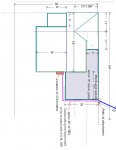WE have a service upgrade on a house with a large porch and the porch continues to become a carport
See drawing on word doc below.... The house is single story with NO ACCESS to the flat roof area unless
you bring a ladder. It is my position that because the flat roof is "isolated" the clearance from the lowest
part of the drip loops above the highest part of the flat roof it crosses only needs to be 3' not 8' or 10

See drawing on word doc below.... The house is single story with NO ACCESS to the flat roof area unless
you bring a ladder. It is my position that because the flat roof is "isolated" the clearance from the lowest
part of the drip loops above the highest part of the flat roof it crosses only needs to be 3' not 8' or 10



